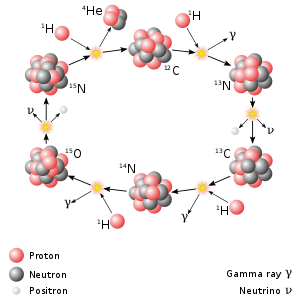Nitrogen-13
| General | |
|---|---|
| Symbol | 13N |
| Names | nitrogen-13, 13N, N-13 |
| Protons (Z) | 7 |
| Neutrons (N) | 6 |
| Nuclide data | |
| Half-life (t1/2) | 9.97 min |
| Parent isotopes | 13O (β+) |
| Decay modes | |
| Decay mode | Decay energy (MeV) |
| β+ | 1.2003 |
| Isotopes of nitrogen Complete table of nuclides | |
Nitrogen-13 (13N) is a radioisotope of nitrogen used in positron emission tomography (PET). It has a half-life of a little under ten minutes, so it must be made at the PET site. A cyclotron may be used for this purpose.
Nitrogen-13 is used to tag ammonia molecules for PET myocardial perfusion imaging.
Production[edit]
Nitrogen-13 is used in medical PET imaging in the form of 13N-labelled ammonia. It can be produced with a medical cyclotron, using a target of pure water with a trace amount of ethanol. The reactants are oxygen-16 (present as H2O) and a proton, and the products are nitrogen-13 and an alpha particle (helium-4).
- 1H + 16O → 13N + 4He
The proton must be accelerated to have total energy greater than 5.66 MeV. This is the threshold energy for this reaction,[1] as it is endothermic (i.e., the mass of the products is greater than the reactants, so energy needs to be supplied which is converted to mass). For this reason, the proton needs to carry extra energy to induce the nuclear reaction.
The energy difference is actually 5.22 MeV, but if the proton only supplied this energy, the reactants would be formed with no kinetic energy. As momentum must be conserved, the true energy that needs to be supplied by the proton is given by:
The presence of ethanol (at a concentration of ~5mM) in aqueous solution allows the convenient formation of ammonia as nitrogen-13 is produced. Other routes of producing 13N-labelled ammonia exist, some of which facilitate co-generation of other light radionuclides for diagnostic imaging.[2][3]

Nitrogen-13 plays a significant role in the CNO cycle, which is the dominant source of energy in main-sequence stars more massive than 1.5 times the mass of the Sun.[4]
Lightning may have a role in the production of nitrogen-13.[5][6]
External links[edit]
- PET site of the University of Melbourne
References[edit]
- ^ Islam, M. R.; Beni, M. S.; Ng, C; et al. (2022). "Proton range monitoring using 13N peak for proton therapy applications". PLOS ONE. 17 (2): e0263521-1–e0263521-18. doi:10.1371/journal.pone.0263521. PMC 8846528. PMID 35167589.
- ^ Biricova, Veronika; Kuruc, Jozef (2007). "Synthesis of the radiopharmaceuticals for positron emission tomography". U.S. Department of Energy, Office of Scientific and Technical Information. Retrieved 4 August 2022.
- ^ Yokell, Daniel L.; Rice, Peter A.; Neelamegam, Ramesh; El Fakhri, Georges (13 May 2020). "Development, validation and regulatory acceptance of improved purification and simplified quality control of [13N] Ammonia". EJNMMI Radiopharm Chem. 5 (11): 11. doi:10.1186/s41181-020-00097-7. PMC 7221112. PMID 32405797.
- ^ Phillips, A.C. (1994). The Physics of Stars. John Wiley & Sons. ISBN 0-471-94057-7.
- ^ "Lightning, with a chance of antimatter". Phys.org. ScienceX. November 22, 2017. Retrieved November 24, 2017.
The gamma rays emitted in lightning have enough energy to knock a neutron out of atmospheric nitrogen
- ^ Castelvecchi, Davide (November 22, 2017). "Lightning makes new isotopes". Nature. doi:10.1038/nature.2017.23033. Retrieved November 29, 2017.

